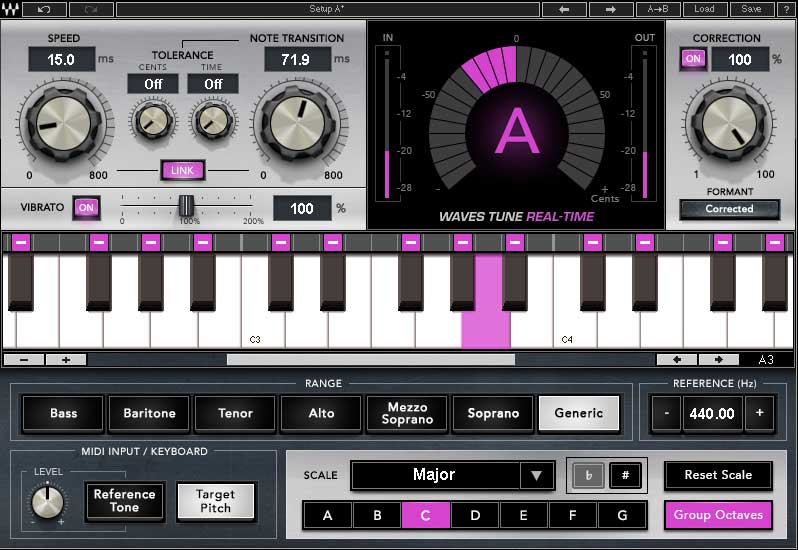

show ()Īs you can see the signal has a period length of roughly 2.27ms which corresponds to a frequency of 440Hz.īut you can also see that the signal is far away from being a pure tone. arange ( 0, sampleDur, 1 / sampleFreq ) plt. read ( "example1.wav" ) sampleDur = len ( myRecording ) / sampleFreq timeX = np. Import scipy.io.wavfile import matplotlib.pyplot as plt import numpy as np sampleFreq, myRecording = scipy. Your browser does not support the audio element. The example is a short recording of me playing the note A 4 with a pitch of 440Hz on a guitar. This might sound abstract at first, so let's "look" at an example. This is easier said than done as you will see )Īfter reading the following section you hopefully know what is meant by pitch detection and which algorithms are suited for this.Īs already mentioned above, pitch and frequencies are not the same. log2 ( pitch / CONCERT_PITCH ) * 12 )) closest_note = ALL_NOTES + str ( 4 + ( i + 9 ) // 12 ) closest_pitch = CONCERT_PITCH * 2 ** ( i / 12 ) return closest_note, closest_pitchĪs next step we need to record the guitar and determine the pitch of the audio signal. The closest note and the corresponding pitch of the closest note.ĬONCERT_PITCH = 440 ALL_NOTES = def find_closest_note ( pitch ): i = int ( np. If we give it a pitch in Hz, it will return This leads us to the following Python function find_closest_note(pitch). Or at least a note which is close to the pitch.Īs you can imagine, this formula will be of particular interest for us.īecause if we can extract the pich from a guitar recoding, we want to know the closest note and how far away it is. This also allows us to assign a pitch a note. So, if you have a pitch \(f_0\), for example A 4 at 440Hz, and you want to increase it by one half step to an A# 4 then you have to multiply The cool thing about the equal temperament is that it defines the notes and pitches in half step fashion described by the following formula:

Note, that for this post we assume an equal temperamentĪnd a concert pitch of A 4=440Hz which covers probably 99% of modern music. Of course all other notes can be assigned to a certain pitch as well: If it would have a pitch of 81Hz, our guitar is out-of-tune and we have to use the tuners on the headstock to get it back in tune. This means that the string has a pitch of 82.41Hz, since this is how the tone E 2 is defined. For example, the lowest string is tuned to the note E 2. Whereby each note refers to one of the strings. I guess most of you know this but the "default" guitar has 6 strings which are usually tuned in the standard tuning EADGBE. With this defintions in mind we will now look at how a guitar works on a musical level. The only kind of tone which will be used is a pure tone.Ī pure tone is a sound with a sinusoidal waveform. The term tone seems to be ambigous, so we rather try to avoid it. It can also carry temporal information like whole notes or half notes, but this is rather uninteresting for us. For example, the well known A 4 is a pitch at 440Hz. This distinction is needed as there are cases where we hear frequencies which are physically not there (or don't hear frequencies which are actually there)!ĭon't worry, we will have a closer look on that subject later.Ī note is just a pitch with a name. Thus, in contrast to frequency which is physical measure, the pitch is a psychoacoustical measure.
Audio tuner program code#
The focus of this post lies on understanding the methods we use and what their pros and cons are.įor those who want to code a guitar tuner in under 60 seconds: my Github repo ) We will start with analyzing the problem we have which is probably a detuned guitar and then forward to solving this problem using math and algorithms.
Audio tuner program software#
(however, I recommend to not use tcl as it is "the best-kept secret in the software industry" and we better keep it a secret, lol).
Audio tuner program free#
Of course the algorithms presented in the post are not bound to Python, so feel free to use any other language if you don't mind the addtional translation You just need a computer with a microphone (or an audio interface) and Python. This project is a pure software project, so there is no soldering or tinkering involved. Hello there! In this post we will program a guitar tuner with Python.


 0 kommentar(er)
0 kommentar(er)
